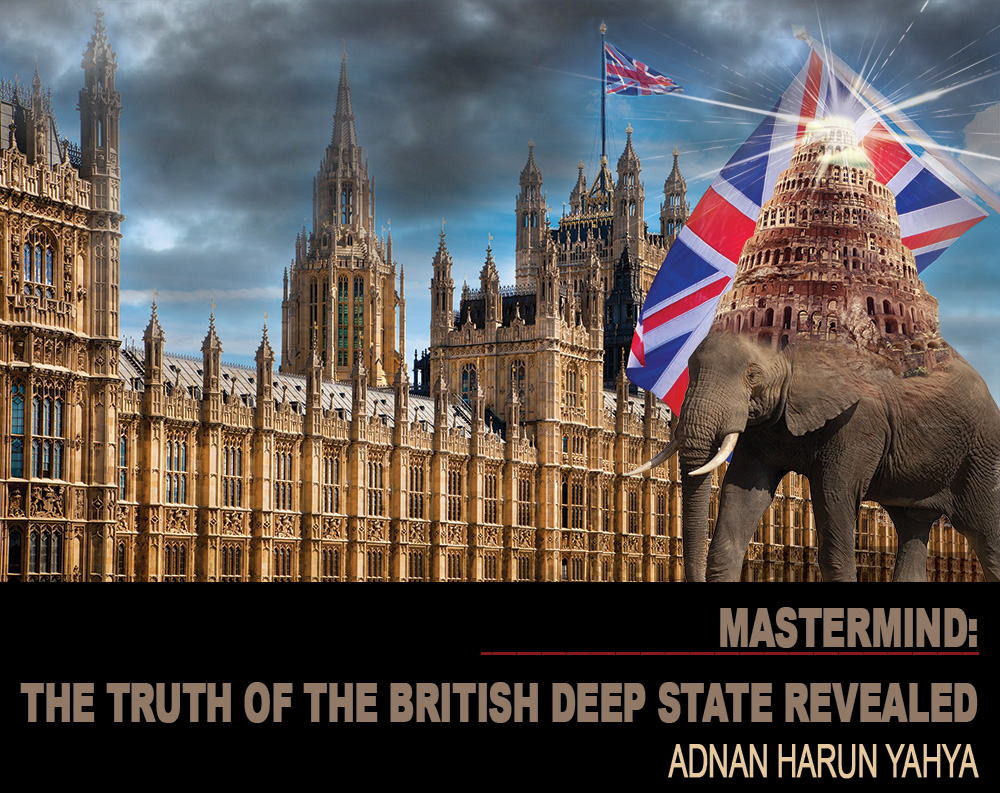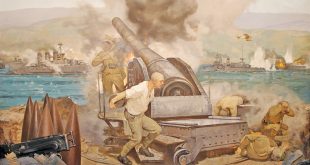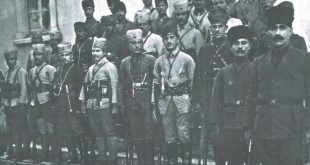The British deep state knew that Istanbul was an important center that effectively disturbed balances in Europe. They also believed that as long as the Turks controlled it, they would continue to disrupt their plans, and so they wanted to remove Istanbul, the Straits and Thrace from the possession of the Turks. They were convinced that the Turkish administration without Istanbul would no longer have a say in matters concerning Europe.
However, the British deep state has always chosen to hide its plans to dismember the Ottoman Empire behind various disguises. During WWI, the pretense this imperialist project used was the supposed goal of protecting minority rights. They spread the wrong notion to the British public that the Ottoman Empire was being ruthless to its Christian subjects, and that Armenians, Greeks, Assyrians and Christian Arabs in the Ottoman lands were under threat. They built these claims on the false allegations that Christians were the real owners of Anatolia and that the Turks had taken it by force. For instance, a member of Parliament Viscount James Bryce said during a speech at the House of Lords, “Asia Minor, Syria, Armenia, and Arabia—have been the homes of ancient civilisations; some of them enjoyed under the Governments which they lead a thousand or fifteen hundred years ago a real national life and prosperity, and had a sense of their place and mission in the world which they have lost under the desolating tyranny that has brooded over them for the last six centuries.” Very conveniently, he maintained that Britain should extend help to those ancient civilizations so that they could regain their freedom. The British deep state claimed that once Istanbul was occupied, the so-called ‘unjust’ policies would come to an end. British newspapers kept claiming that Istanbul wasn’t the national capital of the Turks and that a majority of the population was non-Muslim. However, according to the census of 1919, 67% of the residents of Istanbul were Muslims. The number had been higher, but most Muslims had already been martyred in the Balkan wars and WWI that closely followed it.
Istanbul in the 1900s… |
 |
 |
| Occupation forces in Istanbul |
 |
| Occupation forces in Taksim |
 |
| British troops at the Port of Karaköy, Istanbul, during the years of occupation |
Contrary to the rumors the British deep state sought to spread, minority policies of the Ottoman Empire were impressively liberal and generous. The Ottoman Empire had protected minority rights for 600 years and minorities lived as important parts of the Ottoman nation. As a matter of fact, the members of the minority communities had no trouble ascending the social ladder to achieve administrative positions. Most were engaged in art and commerce and had lived relatively affluent lives in the most beautiful parts of Istanbul and the Ottoman lands in general, and they enjoyed robust support from the Ottoman government. Even after the breakup of the Empire, they continued their presence in Turkey and offered their support for the new Turkish state. The rumors that were spread regarding the minorities were nothing other than black propaganda. Even some of the British spies that came to Istanbul during those years to gather intelligence later admitted that Turkish minority policies were admirable.
Nevertheless, the British deep state continued to spread its black propaganda using the minorities as it was convinced that false claims of ‘persecuted groups, faiths’ would be an effective leverage for influence. They were right. The occupation policies of the British deep state found support in some minority representatives. The Greek Patriarch of Istanbul stated in a letter sent to the Paris Peace Conference that the Question of the East (the plan to break apart the Ottoman Empire) would never be solved until Istanbul was Greek again.
Similarly, the Christian subjects of the Ottoman Empire like the Copts in Egypt, Maronites in Lebanon and Christian Assyrians in Syria, considered Istanbul’s occupation as a step towards their independence and backed the plan. Only the Jews amongst the Ottoman subjects, most notably the Chief Rabbi Nahum Effendi, stood with the Turks against the greedy European occupiers.
British Tactics for the Justification of the Occupation
The British deep state used various methods to occupy Istanbul and similar practices can be still spotted across the world today. Unmasking these tactics is crucial to understanding the danger the world is facing. The plan of removing the Turks from Anatolia, still underway even after 100 years, reached its height with the occupation of Istanbul. To attain this goal, the British deep state didn’t refrain from deceiving even its own public and allies. Millions have been used in this scheme, by a few deep state actors. Let’s see how.
◉ The British Deep State Initially Claimed that It Didn’t Want Anatolia
 |
| Tevfik Pasha, commander of the Seventh Corps in Yemen, was exiled along with other patriot commanders, because he refused to give in to the demands of the British deep state. |
British Prime Minister Lloyd George, during his speech to Parliament on January 5, 1918, reassured Parliament’s Members that there wouldn’t be a war for Istanbul, Anatolia or Thrace. In these lands, the Turkish population was the majority. The truth is, Lloyd George was only trying to cause a diversion and tried to convince his people and the Ottoman Empire that it would not claim these territories.
Furthermore, there was no suggestion of the occupation of Istanbul in the Armistice of Mudros that marked the end of WWI for the Ottoman Empire. On the contrary, Admiral Calthorpe, who signed the Armistice on behalf of the Allied Powers, gave his verbal assurance that the British didn’t intend to occupy Istanbul and terminate the Ottoman administration or seize the control of the Ottoman military forces. The Ottoman delegation that returned to Istanbul after the Armistice brought along the personal letter of Calthorpe with them. In this letter, Calthorpe reassured that French and British soldiers would be stationed only at the Straits and a small unit from the Turkish army would be allowed to remain there as a sign of Ottoman sovereignty.
However, only thirteen days after the Armistice, the British and French troops entered Istanbul. Calthorpe, who had personally promised that Istanbul wouldn’t be occupied, was appointed as the British high commissioner and the first thing he did was arrest two hundred people from Tevfik Pasha’s government and exile thirty of them to Malta. All those who were arrested were Turkish and Muslim administrators. With this move, Calthorpe gave a clear message that Istanbul was under occupation and that anyone refusing to cooperate with the occupational forces would be punished in the harshest manner. He later sent a message to Foreign Office, assuring them that the arrests were “very satisfactory” and intimidated the leaders of a potential insurgency in Istanbul.294
 |
| A Turkish soldier cleaning his shoe before going to the battlefield |
Many officers, who were previously blacklisted during the war, were also exiled. When the British set foot in Istanbul, they started a manhunt not only in Istanbul, but all of Turkey. Their first demand was the capture and punishment of nine Turkish commanders: Ali Ihsan Pasha (Commander of the Sixth Army), Fahrettin Pasha (Commander of V Cavalry Corps), Nuri Pasha (Commander of the Islamic Army of the Caucasus), Mürsel Bey (Commander of the 5th Caucasian Division), Yakub Shevki Pasha (Commander of the Ninth Army), Nihat Pasha (Chief of Staff of the Second Army in Pozanti), Galip Pasha (Commander of the 40th Yemen division) and Tewfik Pasha (Commander of the Seventh Corps in Yemen). It was clear that these Turkish commanders were specifically selected for their outstanding performance against and/or defeat of the British as they bravely defended their country. However, the British deep state failed terribly in its judgment of Turkish patriotism as it believed that targeting commanders would work. As the following days would make clear, capturing and exiling 100-150 people of a deeply patriotic nation who had always lived independently would do nothing to cause them to falter in their fight for independence.
 |
| Following the Armistice of Mudros, the Allied Navy anchored in the Bosphorus on November 13, 1918. |
 |
| (1) Louis Franchet d’Espèrey, the commander of French occupation forces, marching from Galata to Şişhane (2) French commander Louis Franchet d’Espèrey meets British marshall Edmund Allenby in Istanbul port |
Yakub Shevki Pasha, who refused to dissolve the Ninth Army, ignored the British order to hand over arms and ammunition and instead moved his food stocks to the West. Naturally, he was on top of the ‘to be exiled to Malta’ list of the British. Like him, all the members of the Kars Parliament would be exiled to Malta. Halil Pasha and Mehmed Djemal Pasha from the Caucasian Army, and many Turkish officers like Ali Rifat and Mürsel Bey, who were division commanders, were blacklisted by the British in the first months of the Armistice. Meanwhile, the plans to capture, try and exile these commanders were underway in the occupation headquarters.
Many pro-British intellectuals and diplomats considered the promises made prior to the occupation as guarantees. However, after the Armistice, British Prime Minister Lloyd George claimed that his previous statements weren’t a guarantee for the Turks, but were rather intended to reassure his own public and particularly the Indian Muslims who didn’t want to fight other Muslims. He hoped that this would justify the occupation.
It is important to keep one thing in mind: the British deep state might make statements to create a diversion, they might pretend to be friends, make promises or sign official letters. However, all these promises have absolutely no effect on the representatives of the deep state and their determination to carry out their original plans. They will never stop trying to realize their sinister plans made centuries ago behind closed doors. Therefore, falling for deceptive words could prove disastrous for the future.
◉ The British Deep State Assured Its Allies that Anatolia Would Be a US Mandate
In the aftermath of WWI, maps were redrawn in the Paris Peace Conference of 1919. Representatives from 32 countries attended the conference. It started on January 18, 1919 and a total of 1646 sessions took place in the months-long event. However, this wide attendance was only to keep up appearances. The real decisions in the conference were made by the so-called ‘Big Four’: British Prime Minister Lloyd George, US President Woodrow Wilson, French Prime Minister Georges Clemenceau, and Italian Prime Minister Vittorio Emanuele Orlando.
The five treaties that ended the war were drafted in the Paris Peace Conference: The Treaty of Versailles that was signed with Germany the same year, the Treaty of Saint-Germain-en-Laye with the Republic of German-Austria, Treaties of Neuilly-sur-Seine with Bulgaria and Trianon with Hungary, and the Treaty of Sèvres with the Ottoman Empire were all outlined during this conference.
Before moving on to examining the plans to break apart the Ottoman Empire, we should briefly touch on the Treaty of Versailles. Prior to Versailles, the German public was assured that the principles known as Wilson’s Fourteen Points would be the foundations for the treaty. However, once the time for signatures arrived, a heavy colonization plan appeared that was a complete insult to Germans in every way. The harsh conditions forced the German economy to work for the Allied Powers for years. Many historians agree that the harsh terms of this treaty led to the rise of Nazi regime and vengeful sentiments in the German public.
 |
| A painting depicting the Treaty of Versailles signed with Germany. According to many historians, the harsh conditions of the treaty played the biggest role in the rise of the German Nazi Party. |
Britain and France made a deal during the Paris Peace Conference to share the Ottoman lands in Arabia, Thrace, the Mediterranean and the Aegean amongst themselves. They wanted to make Turkey a small Asian country trapped inside Anatolia. According to their plan, little Turkey trapped in this piece of land would be placed under US mandate.
In other words, the plan of the British deep state for the Paris Peace Conference was placing countries they considered incapable of ruling themselves under the mandate of developed countries. The Middle East was distributed according to this plan. Britain presented a proposal to the Conference on May 21, 1919 and suggested that Mesopotamia, Syria and Palestine be placed under French and British mandate, and the Ottoman Empire under US mandate. Let’s find out about the truth of this plan from the telegram Halide Edip Adıvar sent to Mustafa Kemal Pasha on August 10, 1919:
 |
| 1.British Prime Minister David Lloyd George, Italian Prime Minister Vittorio Orlando, French Prime Minister Georges Clemenceau, and US President Woodrow Wilson at the Paris Peace Conference
2. A picture from the Paris Peace Conference |
The situation in Constantinople relating to foreign affairs is this:
Although France, Italy and England have offered a mandate over Turkey to the American Senate, they are trying by all possible means to prevent them from accepting it.
There is no doubt that each of these Powers wants to make certain of their share when the country is divided up.
France, having met with disappointments in Syria, wants to compensate herself in Turkey. Italy, being frankly and openly imperialistic, declares plainly that she has entered the war with the sole object of getting a good share of the Anatolian booty.
The part played by England is rather more complicated.
With an eye to the future, England has no desire that Turkey shall remain united or become modernised or enjoy real independence. A Turco-Mohamedan State, powerful and equipped with all modern requirements and ideas, and particularly with a Caliph at its head, would be an exceedingly bad example to the Mohamedan subjects of England.
If she could get power over Turkey without being interfered with at all, she would soon decapitate and dismember her without any compunction, and would try within a few years to convert her into a loyal colony.295
Clearly, the plans of the British deep state have always been more sinister and more complicated. Supporting a US mandate was just an act. The true desire of the British deep state, for a long time, had been a completely disintegrated, weakened, devastated Turkish state.
In order to accurately analyze the plans of the British deep state, it is important to look a couple steps ahead. We shouldn’t forget that although intended for Churchill, the statement “he was ‘first, last and all the time a great Englishman, more interested in preserving England’s position in Europe than in preserving the peace”296 actually applies to every member of the deep state because for the British deep state, there are no allies or friends. Everyone in the plan is a means to get to an end. Their existence serves the deep state plans. This is true even for the seemingly most powerful leaders of the world as they have no option other than playing along according to the script they have been given.
◉ Italians Weren’t Spared the Deep Strategies of the British Deep State, Either
As the WWI raged on, the Allied Powers had secret meetings to agree on a plan for the partition of the Ottoman Empire. The first secret agreement, known as the Treaty of London, was signed in 1915. According to this secret pact between the Triple Entente (Britain, France, Russia) and Italy, Italians were promised Antalya and surrounding Mediterranean regions in exchange for joining the war on the side of the Allied Powers. Due to the Bolshevik Revolution, this treaty was replaced by the Agreement of St.-Jean-de-Maurienne of 1917, which was signed by only Italy, France and Britain. According to the new plan, Italians would also be given Western Anatolia including Izmir, in addition to the coastline of the Mediterranean.
 |
| 1. The picture shows a parade of Greek soldiers in Izmir, who believed in this promise.
2. An illustration depicting Greek ideals during the Greek occupation of Izmir. The British deep state took advantage of the imperialist ambitions of the Greeks. It was too late when the Greeks realized that they were deceived. |
Once again, the post-war scene wasn’t playing out according to the expectations of the Italians, but was very conveniently going according to the original plans of the British. Eleftherios Venizelos-Lloyd George cooperation resulted in the Greek forces’ occupation of Izmir on May 15, 1919, and Western Anatolia remained under Greek occupation until September 9, 1922, when they were forced to retreat by the Turkish army. The British deep state, taking advantage of the imperialist Greek dreams, built an army in Anatolia that would do its bidding. This also effectively prevented Italy from having the sole say in the region. The whole occupation plan was based on the propaganda that local Christian people needed protection from the so-called Muslim gangs and this sinister plan was thus given international legitimacy. However, it was clearly established with the following report of the Inter-Allied Commission of Inquiry, based in Istanbul, on October 12, 1919 that those allegations were complete lies:
The inquiry has proven that the general situation of Christians in the vilayet of Aydin has been satisfactory since the armistice and that they have not been in danger. – Security in the vilayet of Aydin, and in Smyrna [Izmir] in particular, in no way justified the occupation of Smyrna’s forts by application of Article 7 of the armistice. Furthermore, the situation in the vilayet did not justify the landing of allied troops in Smyrna. 297
Even this report wasn’t enough to stop the British deep state plans.
 |
| 1. Occupation forces landing at Izmir
2.The British deep state promised to give Izmir to Greece. (Above) Greek army at Izmir port |
The British deep state used Italians when it needed, with the pretense of being a reliable ally and with a couple of promises. But when it no longer needed Italy, it left it alone. Needless to say, Italians themselves had nefarious occupation plans regarding the Ottoman lands just like other Allied powers, and in this regard, Italy then was just as guilty as others. The point is, even towards its own allies, the British deep state always follows a self-centered and double-faced policy.
Mustafa Kemal, the leader of the Turkish War of Independence and the savior of the Turkish people and Turkey, took advantage of this double-faced policy of the British: After 1920, the Italian government began to provide weapons, logistics and intelligence to the Turkish nationalists.
 |
| The Armistice of Mudros was signed aboard this ship. |
 |
| Allied ships at the Bosphorus after the signing of the Armistice of Mudros |
 |
| A map that shows the occupied territories after the signing of the Armistice of Mudros |
◉ A Claim of Upholding Minority Rights is a Typical British Deep State Method for Justification of Its Occupations
According to the Armistice of Mudros signed after the war, the Allied armies should have stayed in their current positions and no occupation would take place unless there was a threat. However, as explained previously, the British nevertheless occupied Istanbul and the Greek landed and took over Izmir. The only so-called justification for these occupations was the false claim that the Christian minorities were in danger. The 7th clause of the Armistice of Mudros gave the Allied Powers the right to occupy strategic locations in case of a security threat. By combining the occupation right granted under the 7th clause with the so-called threats the minorities supposedly faced, the occupation of Anatolia was cunningly made compliant with the international law.
However, the air in the capital in the first few days after the Armistice was signed was very different. The Ottoman Parliament unanimously ratified the Armistice. The Ottoman Postal Office printed stamps for the Armistice, as if celebrating good news. Only ten days after the optimistic statements of the Ottoman Minister of Marine Affairs Rauf Bey, on November 13, 1918, the 55-unit enemy fleet passed through the Dardanelles Strait and anchored in Dolmabahce. This huge fleet consisted of 22 British, 17 Italian, 12 French and 4 Greek warships.
 |
| Italian soldiers drilling in front of the Dolmabahçe Palace |
This occupation represented the pinnacle of the centuries-old British deep state plans to disintegrate the Ottoman Empire and remove the Turks from Europe. The capital was occupied, the army was dissolved, and commercial vessels, shipyards, ports, railways and communication channels were made available for the sole use of the occupation forces. This entire plan was carried out with a legal pretense and was supported by military force. Furthermore, black propaganda was used widely to stem any potential public support for the Ottoman administration.
 |
| Rowdy British soldiers drinking and acting obnoxiously at Marmara shores during the occupation of Istanbul |
The anti-Ottoman sentiment that was propagated in Europe and the United States for years through newspapers, novels and theatrical plays were all intended to make this occupation easier. Hundreds of books, pamphlets and brochures printed with caricatures depicting Turks as savage people served the purpose of building a Muslim Turk image that supposedly massacred Christians. The propaganda machine raged on to convince the world opinion, most notably the US and British public, that the Ottoman Empire had to come down for the sake of Christianity, freedom and human rights. Any opposing voices that might have stood up for the rights of the Ottoman and for justice were silenced in advance. The British deep state made sure that there were no loopholes in the plan. Even though this sinister plan came to a staggering 100-year-old halt with the Anatolian War of Independence, today it is still on the agenda. Currently, the Anatolian lands are surrounded from every direction, and the spirit of solidarity and patriotism is the only power that can stand up to this conspiracy.
If God helps you, no one can vanquish you. If He forsakes you, who can help you after that? So the believers should put their trust in God. (Qur’an, 3:160)
 |
| (1) Allied fleet off Dolmabahçe during the years of occupation (2) Allied troops landing at Sarayburnu (3) The Saturday Evening Post, published in the US in 1910 depicts Turkish soldiers as savage barbarians. During those years, the US media obtained most of its intelligence about the Middle East through British, which resulted in a horrible perception of ‘Turks’. (Turkish nation is above such allegations). |
A journalist with the British deep state: Walter Lippmann
According to many sources, Wilson’s Fourteen Points, which were supposed to be the basis of the treaties to be signed after WWI, were prepared by the British government with the input of Walter Lippmann, a Harvard graduate who worked as an adviser to the US President Wilson. These principles were supposed to be used for the peace negotiations. However, it later became clear both at Versailles and Sèvres that the document didn’t have a trace of a peaceful approach or the signature of Wilson. Journalist Lippmann, who drafted the Fourteen Points, later became an executive in CFR (Council on Foreign Relations), the American sister organization of Chatham House, which is known as an institute under the influence of the British deep state. He worked as a non-official adviser to eight US presidents. With the book he wrote in 1946, he was the first to introduce the concept of ‘Cold War’. Today, many call Lippmann the ‘most influential journalist of the 20th century’, or ‘the founding father of modern journalism’. Presidents, prime ministers, ministers might change; but the members of the deep state, deeply embedded, do not change.
Footnotes:
294. Gary Jonathan Bass, Stay the Hand of Vengeance: The Politics of War Crimes Tribunals, Princeton University Press, p. 121
295. Mustafa Kemal Atatürk, Nutuk [The Great Speech]
296. Robin Renwick, Fighting with Allies: America and Britain in Peace and War, Palgrave Macmillan, 1996, p. 89
297. Documents of the Inter-Allied Commission of Inquiry-Appendices: Documents of the Inter-Allied Commission of Inquiry into the Greek Occupation of Smyrna and Adjoining Territories, http://www.ataa.org/reference/iacom.pdf
 British Deep State MASTERMIND: THE TRUTH OF THE BRITISH DEEP STATE REVEALED
British Deep State MASTERMIND: THE TRUTH OF THE BRITISH DEEP STATE REVEALED



